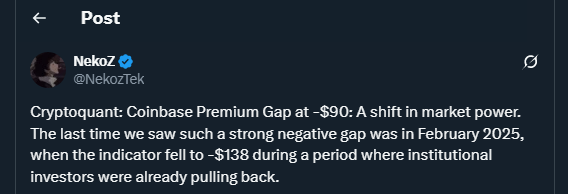TL;DR
- A sharp drop in the Coinbase Bitcoin Premium signals weaker U.S. demand while selling pressure remains persistent.
- Extended negative data from Coinglass and CryptoQuant for more than two weeks points to institutional profit-taking instead of broad selling.
- Meanwhile, Asian and European markets show rising spot flows, highlighting a geographic shift of liquidity, not a structural decline in Bitcoin demand.
Bitcoin trading on Coinbase shows a clear decline in spot demand coming from U.S. markets. A closely watched indicator tracking institutional appetite remains negative, and analysts highlight a sustained period of selling rather than accumulation. The pattern suggests a shift in liquidity leadership and growing influence from non-U.S. trading venues.
Coinbase Premium Signals Weakening U.S. Demand For Bitcoin
The Coinbase Premium Index compares Bitcoin prices on Coinbase with other global exchanges. Over recent sessions, the index has stayed below zero, meaning Bitcoin trades at a discount on Coinbase relative to offshore platforms. Coinglass data shows persistent red readings while prices fluctuate around $90,000. Analysts note that discount phases often coincide with rebalancing among large market participants, who adjust exposure through short-term rotation without fully exiting their BTC positions.
This pressure mirrors a previous stress zone seen in February, when the premium dropped to nearly minus $138. At that time, several institutional desks in the United States reduced spot allocation after months of rapid accumulation. Analysts argue the current move reflects profit realization rather than a bearish market shift. Selling appears concentrated among U.S. entities trimming exposure, not a collapse in global demand.
Global Liquidity Rises As Offshore Trading Strengthens
While U.S. demand cools, offshore exchanges are reporting stronger flows backed by stablecoin inflows in USDT and USDC. CryptoQuant highlights continued growth in Asian spot activity, with regional funds expanding their positions. In addition, data from Kaiko shows deeper order books on several Asian platforms, suggesting liquidity providers are responding to increasing regional participation.

Recent market developments illustrate this shift. Hong Kong’s spot Bitcoin ETFs have surpassed $2 billion in cumulative volume, attracting increasingly large market players, while market-making desks in Singapore have expanded BTC reserves to serve regional demand. These movements signal a growing role for non-U.S. markets in Bitcoin price formation.
The negative Coinbase premium reflects institutional rebalancing in the United States after a long accumulation phase. Rather than signaling a downturn, current data points to a rotation of liquidity toward offshore exchanges.











